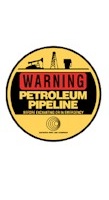Since pipelines are usually buried underground, line markers and warning signs are used to indicate their presence in an area along the pipeline route. Here are examples of some of these markers.
 |
 |
 |
Markers and warning signs are located at frequent intervals along transmission and liquid pipeline rights-of-way (ROW). They are found where a pipeline intersects a street, highway, railway or waterway, and at other prominent points along the route. Markers warn that a transmission pipeline is located in the area, identify the product transported in the line, and provide the name of the pipeline operator and a telephone number to call in the event of an emergency.
Pipeline markers indicate only the presence of a pipeline. They can not be relied upon to determine the exact location of the pipeline. Pipeline locations within a ROW may vary along the length of the ROW. Additionally, there may be multiple pipelines located in the same ROW.
Before digging in the area, all excavators, including the general public, should call their State One-Call Center to ensure that the underground pipelines are accurately marked. Calling 811 will connect you with the appropriate One-Call Center. The One-Call process is designed to protect both people and property. So Call Before You Dig - it's the law.
In some cases, the transmission pipeline operator may require that any excavation near its pipelines be monitored by qualified personnel. The risk of excavation damage to transmission pipelines can be reduced when qualified personnel familiar with the pipeline system monitor excavations.
PHMSA hosted a Pipeline Marker Workshop in February 2008, in Houston, TX, to begin work to develop uniform, nationwide expectations for pipeline marker location and content and OPS enforcement policy to further reduce the risk of excavation damage to gas transmission and hazardous liquid pipelines. Presentation files are available from the meeting.

